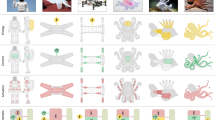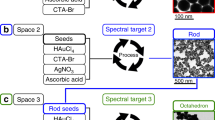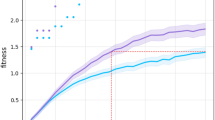Abstract
Natural lifeforms specialize to their environmental niches across many levels, from low-level features such as DNA and proteins, through to higher-level artefacts including eyes, limbs and overarching body plans. We propose ‘multi-level evolution’, a bottom-up automatic process that designs robots across multiple levels and niches them to tasks and environmental conditions. Multi-level evolution concurrently explores constituent molecular and material building blocks, as well as their possible assemblies into specialized morphological and sensorimotor configurations. Multi-level evolution provides a route to fully harness a recent explosion in available candidate materials and ongoing advances in rapid manufacturing processes. We outline a feasible architecture that realizes this vision, highlight the main roadblocks and how they may be overcome, and show robotic applications to which multi-level evolution is particularly suited. By forming a research agenda to stimulate discussion between researchers in related fields, we hope to inspire the pursuit of multi-level robotic design all the way from material to machine.
This is a preview of subscription content, access via your institution
Access options
Access Nature and 54 other Nature Portfolio journals
Get Nature+, our best-value online-access subscription
$29.99 / 30 days
cancel any time
Subscribe to this journal
Receive 12 digital issues and online access to articles
$119.00 per year
only $9.92 per issue
Buy this article
- Purchase on Springer Link
- Instant access to full article PDF
Prices may be subject to local taxes which are calculated during checkout


Christopher Michel (Antarctica); Jean-Baptiste Mouret (Amazon); and Dimitry B. (Sahara)
Similar content being viewed by others
References
Carlson, J. & Murphy, R. R. How UGVs physically fail in the field. IEEE Trans. Robot. 21, 423–437 (2005).
Atkeson, C. G. et al. in The DARPA Robotics Challenge Finals: Humanoid Robots to the Rescue (eds Spenko, M., Buerger, S. & Iagnemma, K.) 667–684 (Springer Tracts in Advanced Robotics, Springer, Basel, 2018).
Barrett, L. Beyond the Brain: How Body and Environment Shape Animal and Human minds (Princeton Univ. Press, Princeton, 2011).
Pfeifer, R. & Bongard, J. How the Body Shapes the Way We Think: A New View of Intelligence (MIT Press, Cambridge, 2006).
Carroll, S. B., Grenier, J. K. & Weatherbee, S. D. From DNA to Diversity: Molecular Genetics and the Evolution of Animal Design (Wiley, New York, 2013).
Brooks, R. A. Intelligence without representation. Artif. Intell. 47, 139–159 (1991).
Salimans, T., Ho, J., Chen, X., Sidor, S. & Sutskever, I. Evolution strategies as a scalable alternative to reinforcement learning. Preprint at https://arxiv.org/abs/1703.03864 (2017).
Le, T. C. & Winkler, D. A. Discovery and optimization of materials using evolutionary approaches. Chem. Rev. 116, 6107–6132 (2016).
Fischer, P., Nelson, B. & Yang, G.-Z. New materials for next-generation robots.Sci. Robot. 3, eaau0448 (2018).
Soldatova, L. N., Clare, A., Sparkes, A. & King, R. D. An ontology for a robot scientist. Bioinformatics 22, E464–E471 (2006).
Maier, W. F., Stoewe, K. & Sieg, S. Combinatorial and high-throughput materials science. Angew. Chem. Int. Ed. 46, 6016–6067 (2007).
Sans, V. & Cronin, L. Towards dial-a-molecule by integrating continuous flow, analytics and self-optimisation. Chem. Soc. Rev. 45, 2032–2043 (2016).
King, R. D. in KI 2015: Advances in Artificial Intelligence (eds Hölldobler, S., Krötzsch, M., Peñaloza, R. & Rudolph, S.) xiv–xv (Springer, Cham, 2015).
Granda, J. M., Donina, L., Dragone, V., Long, D. L. & Cronin, L. Controlling an organic synthesis robot with machine learning to search for new reactivity. Nature 559, 377–381 (2018).
Curtarolo, S. et al. The high-throughput highway to computational materials design. Nat. Mater. 12, 191–201 (2013).
Pyzer-Knapp, E. O., Suh, C., Gomez-Bombarelli, R., Aguilera-Iparraguirre, J. & Aspuru-Guzik, A. What is high-throughput virtual screening? A perspective from organic materials discovery. Annu. Rev. Mater. Res. 45, 195–216 (2015).
Meng, Y., Correll, N., Kramer, R. & Paik, J. Will robots be bodies with brains or brains with bodies? Sci. Robot. 2, eaar4527 (2017).
Calignano, F. et al. Overview on additive manufacturing technologies. Proc. IEEE 105, 593–612 (2017).
Li, L., Haghighi, A. & Yang, Y. A novel 6-axis hybrid additive-subtractive manufacturing process: design and case studies. J. Manuf. Process. 33, 150–160 (2018).
Eujin, P. et al. A study of 4D printing and functionally graded additive manufacturing. Assem. Autom. 37, 147–153 (2017).
Martínez, J., Hornus, S., Song, H. & Lefebvre, S. Polyhedral Voronoi diagrams for additive manufacturing. ACM Trans. Graph. 37, 129 (2018).
Chen, T., Mueller, J. & Shea, K. Integrated design and simulation of tunable, multi-state structures fabricated monolithically with multi-material 3D printing. Sci. Rep. 7, 45671 (2017).
Haghiashtiani, G. et al. 3D printed electrically-driven soft actuators. Extreme Mech. Lett. 21, 1–8 (2018).
Rosendo, A., Von Atzigen, M. & Iida, F. The trade-off between morphology and control in the co-optimized design of robots. PLoS One 12, e0186107 (2017).
Brodbeck, L., Hauser, S. & Iida, F. Morphological evolution of physical robots through model-free phenotype development. PLoS One 10, e0128444 (2015).
Wehner, M. et al. An integrated design and fabrication strategy for entirely soft, autonomous robots. Nature 536, 451–455 (2016).
Silva, F., Duarte, M., Correia, L., Oliveira, S. M. & Christensen, A. L. Open issues in evolutionary robotics. Evol. Comput. 24, 205–236 (2016).
Hornby, G. S., Lohn, J. D. & Linden, D. S. Computer-automated evolution of an X-band antenna for NASA’s Space Technology 5 mission. Evol. Comput. 19, 1–23 (2011).
Auerbach, J. E. & Bongard, J. C. Environmental influence on the evolution of morphological complexity in machines. PLoS Comput. Biol. 10, e1003399 (2014).
Lehman, J. et al. The surprising creativity of digital evolution: a collection of anecdotes from the evolutionary computation and artificial life research communities. Preprint at https://arxiv.org/abs/1803.03453 (2018).
Nolfi, S. & Floreano, D. Evolutionary Robotics: The Biology, Intelligence, and Technology of Self-Organizing Machines (MIT Press, Cambridge, 2000).
Lipson, H. & Pollack, J. B. Automatic design and manufacture of robotic lifeforms. Nature 406, 974–978 (2000).
Eiben, A. E., Kernbach, S. & Haasdijk, E. Embodied artificial evolution—artificial evolutionary systems in the 21st century. Evolut. Intell. 5, 261–272 (2012).
Eiben, A. E. & Smith, J. From evolutionary computation to the evolution of things. Nature 521, 476–482 (2015).
Rieffel, J., Mouret, J.-B., Bredeche, N. & Haasdijk, E. Introduction to the evolution of physical systems special issue. Artif. Life 23, 119–123 (2017).
Cheney, N., MacCurdey, R., Clune, J. & Lipson, H. Unshackling evolution: evolving soft robots with multiple materials and a powerful generative encoding. In Proc. GECCO’13 (ed. Blum, C.) 167–174 (ACM, 2013).
Eiben, A. E. & Smith, J. E. Introduction to Evolutionary Computing (Springer, Berlin, 2003).
Stanley, K. O. Compositional pattern producing networks: a novel abstraction of development. Genet. Program. Evolv. Mach. 8, 131–162 (2007).
Doncieux, S., Bredeche, N., Mouret, J.-B. & Eiben, A. E. G. Evolutionary robotics: what, why, and where to. Front. Robot. AI 2, 10.3389/frobt.2015.00004 (2015).
Rabitz, H. Control in the sciences over vast length and time scales. Quant. Phys. Lett. 1, 1–19 (2012).
Hansch, C et al. Exploring QSAR: Fundamentals and Applications in Chemistry and Biology (American Chemical Society, Washington DC, 1995).
Mouret, J.-B. & Clune, J. Illuminating search spaces by mapping elites. Preprint at https://arxiv.org/abs/1504.04909 (2015).
Pugh, J. K., Soros, L. B. & Stanley, K. O. Quality diversity: a new frontier for evolutionary computation. Front. Robot. AI 3, 40 (2016).
Vassiliades, V., Chatzilygeroudis, K. & Mouret, J.-B. Using centroidal voronoi tessellations to scale up the multidimensional archive of phenotypic elites algorithm. IEEE Trans. Evolut. Comput. 22, 623–630 (2018).
Stanley, K. O., Clune, J., Lehman, J. & Miikkulainen, R. Designing neural networks through neuroevolution. Nat. Mach. Intell. https://doi.org/10.1038/s42256-018-0006-z (2019).
Figueiredo, M. A. et al. Adaptive sparseness for supervised learning. IEEE Trans. Pattern Anal. Mach. Intell. 25, 1150–1159 (2003).
Tibshirani, R. Regression shrinkage and selection via the lasso. J. R. Statist. Soc. B 58, 267–288 (1996).
Cully, A. & Demiris, Y. Hierarchical behavioral repertoires with unsupervised descriptors. In Proc. GECCO'18 (ed. Aguirre, H.) 69–76 (ACM, 2018).
Kriegman, S., Cheney, N., Corucci, F. & Bongard, J. C. Interoceptive robustness through environment-mediated morphological development. Preprint at https://arxiv.org/abs/1804.02257 (2018).
Hauser, H., Ijspeert, A. J., Füchslin, R. M., Pfeifer, R. & Maass, W. Towards a theoretical foundation for morphological computation with compliant bodies. Biol. Cybern. 105, 355–370 (2011).
Eiben, A. E. et al. The triangle of life: evolving robots in real-time and real-space. In Proc. ECAL 2013 (eds Liò, P., Miglino, O., Nicosia, G., Nolfi, S. & Pavone, M.) 1056–1063 (MIT Press, Cambridge, 2013).
Cully, A., Clune, J., Tarapore, D. & Mouret, J.-B. Robots that can adapt like animals. Nature 521, 503–507 (2015).
Bhattacharya, M. Evolutionary approaches to expensive optimisation. Preprint at https://arxiv.org/abs/1303.2745 (2013).
Howard, D. A platform that directly evolves multirotor controllers. IEEE Trans. Evol. Comput. 21, 943–955 (2017).
Heijnen, H., Howard, D. & Kottege, N. A testbed that evolves hexapod controllers in hardware. In 2017 IEEE International Conference on Robotics and Automation (ICRA) 1065–1071 (IEEE, 2017).
Bäck, T., Keßler, L. & Heinle, I. Evolutionary strategies for identification and validation of material model parameters for forming simulations. In Proc. GECCO'11 (ed. Lanzi, P. L.) 1779–1786 (ACM, 2011).
Hüsken, M., Jin, Y. & Sendhoff, B. Structure optimization of neural networks for evolutionary design optimization. Soft Comput. 9, 21–28 (2005).
Rasmussen, C. E. & Williams, C. K. I. Gaussian Processes for Machine Learning (MIT Press, Cambridge, 2006)
Jin, Y. Surrogate-assisted evolutionary computation: recent advances and future challenges. Swarm Evolut. Comput. 1, 61–70 (2011).
Winkler, D. A. & Le, T. C. Performance of deep and shallow neural networks, the universal approximation theorem, activity cliffs, and QSAR. Mol. Inform. 36, 1600118 (2017).
Gaier, A., Asteroth, A. & Mouret, J.-B. Data-efficient design exploration through surrogate-assisted illumination. Evol. Comput. 26, 381–410 (2018).
Chatzilygeroudis, K. et al. Black-box data-efficient policy search for robotics. In Proc. IROS 2017 51–58 (IEEE, 2017).
Bongard, J., Zykov, V. & Lipson, H. Resilient machines through continuous self-modeling. Science 314, 1118–1121 (2006).
Zagal, J. C. & Ruiz-Del-Solar, J. Combining simulation and reality in evolutionary robotics. J. Intell. Robot. Syst. 50, 19–39 (2007).
Chatzilygeroudis, K. & Mouret, J.-B. Using parameterized black-box priors to scale up model-based policy search for robotics. In Proc. ICRA 2018 1–9 (IEEE, 2018).
Koos, S., Mouret, J.-B. & Doncieux, S. The transferability approach: crossing the reality gap in evolutionary robotics. IEEE Trans. Evolut. Comput. 17, 122–145 (2013).
Donoho, D. L. High-dimensional data analysis: the curses and blessings of dimensionality. AMS Math. Chall. Lect. 1, 32 (2000).
Wagy, M. D. & Bongard, J. C. Combining computational and social effort for collaborative problem solving. PLoS One 10, e0142524 (2015).
Jain, A. et al. Commentary: the materials project: a materials genome approach to accelerating materials innovation. APL Mater. 1, 011002 (2013).
Tolley, M. T. et al. A resilient, untethered soft robot. Soft Robot. 1, 213–223 (2014).
Rus, D. & Tolley, M. T. Design, fabrication and control of soft robots. Nature 521, 467–475 (2015).
Lipson, H. Challenges and opportunities for design, simulation, and fabrication of soft robots. Soft Robot. 1, 21–27 (2014).
Yeom, S.-W. & Oh, I.-K. A biomimetic jellyfish robot based on ionic polymer metal composite actuators. Smart Mater. Struct. 18, 085002 (2009).
Manti, M., Cacucciolo, V. & Cianchetti, M. Stiffening in soft robotics a review of the state of the art. IEEE Robot. Autom. Mag. 23, 93–106 (2016).
Bauer, S. et al. 25th anniversary article: A soft future: from robots and sensor skin to energy harvesters. Adv. Mater. 26, 149–162 (2014).
Han, S.-T. et al. An overview of the development of flexible sensors. Adv. Mater. 29, 1700375 (2017).
Miriyev, A., Stack, K. & Lipson, H. Soft material for soft actuators. Nat. Commun. 8, 596 (2017).
Acknowledgements
D.H., D.F.K., P.V. and D.W. would like to acknowledge Active Integrated Matter, one of CSIRO’s Future Science Platforms, for funding this research. J.-B.M. is funded by the European Union’s Horizon 2020 research and innovation programme (grant agreement no. 637972, project ‘ResiBots’).
Author information
Authors and Affiliations
Contributions
All authors contributed in forming the concept of multi-level evolution, and to the writing of the Perspective. D.H., J.-B.M., P.V., D.W. and A.E contributed on the evolutionary side, and D.F.K. and D.W. on the materials side.
Corresponding author
Ethics declarations
Competing interests
The authors declare no competing interests.
Additional information
Publisher’s note: Springer Nature remains neutral with regard to jurisdictional claims in published maps and institutional affiliations.
Rights and permissions
About this article
Cite this article
Howard, D., Eiben, A.E., Kennedy, D.F. et al. Evolving embodied intelligence from materials to machines. Nat Mach Intell 1, 12–19 (2019). https://doi.org/10.1038/s42256-018-0009-9
Received:
Accepted:
Published:
Issue Date:
DOI: https://doi.org/10.1038/s42256-018-0009-9
This article is cited by
-
Enhancing robot evolution through Lamarckian principles
Scientific Reports (2023)
-
Man is a “Rope” Stretched Between Virosphere and Humanoid Robots: On the Urgent Need of an Ethical Code for Ecosystem Survival
Foundations of Science (2022)
-
A soft robot that adapts to environments through shape change
Nature Machine Intelligence (2020)
-
Skills for physical artificial intelligence
Nature Machine Intelligence (2020)
-
Designing neural networks through neuroevolution
Nature Machine Intelligence (2019)



